
Accelerating eCommerce development workflows: from staging to production
WordPressdeveloper workflow
10 September 2025
This post is also available in French.
Last summer, a single security software update brought the Starbucks mobile app to a halt across the globe. Customers couldn't place orders, payments failed, and a multi-billion dollar business was disrupted—not because of an internal bug, but due to a failure in a third-party service. This is the new reality of eCommerce.
Shoppers do not wait. When a site loads slowly, they leave. If checkout fails, they abandon. When a new feature crashes, complaints hit social media before IT can respond. The pressure on eCommerce teams is relentless. They have to ship faster, add personalization, and keep everything running smoothly.
This is why smarter workflows became essential. Manual deploys and late-night fixes could not keep pace with modern demands. Real-time inventory, secure payments, multi-device shopping, and constant A/B testing all require speed and reliability. Businesses want agility. Customers expect perfection. Developers are caught in the middle, asked to deliver both.
This article explores that tension. It is the tug of war between speed and safety in modern eCommerce development services. It is not only a technical challenge but an organizational one. The companies that solve it build systems where agility does not mean instability. The reward is a development engine that moves quickly, learns quickly, and stays safe.
The question now is how teams can keep up the pace without sacrificing stability. Let’s look at how smarter eCommerce development workflows make that possible.
What slows down a developer: the workflow trap no one talks about
Let’s imagine something simple.
A developer rolls out a new feature like a personalized product carousel designed to boost holiday sales. It’s tested locally. Everything runs smooth. But the moment it’s pushed to staging, the carousel breaks. Not because the code is wrong, but because the staging server runs an outdated version of the API.
Slack messages fly. QA gets looped in. Logs are scanned. The issue is traced, but valuable time is already lost: 24 hours of debugging, cross-departmental meetings, and missed deadlines. Marketing wants it live. Engineering wants it fixed. The feature, caught between silos, stalls. And the company loses an entire day of crucial sales!
This is the unspoken truth of most eCommerce development company workflows: they look efficient on paper, but they bleed velocity in real life.
What is the traditional workflow in eCommerce development?
Typically, it goes like this:
- Code locally
- Push to staging
- QA tests it
- Move to production
Seems clean. But here’s what really happens:
Environment inconsistencies
What works on a developer’s machine may break in staging. And what clears staging might behave erratically in production. Without environmental parity, you’re debugging ghosts, bugs that appear only when it's too late to trace them properly.
Delayed feedback loops
Developers commit changes. QA queues it up. Business stakeholders review it much later. By the time feedback arrives, context has evaporated and urgency with it. The fix, once a 5-minute change, now costs hours.
Manual testing and deployments
Click. Wait. Confirm. Approve. Ship. This slow, brittle routine mimics agility but functions like a waterfall. And in a business built on speed, it’s a luxury few can afford.
High-Risk Releases
Even a minor UI tweak can feel like defusing a bomb. Will it impact payments? Break cart logic? There’s no safe space to fail, so everything moves slower, with fear built in.
And that fear? That’s what’s killing innovation.
The problem isn’t the people. It’s the process. You can’t drive a Formula 1 car with the rules of a bicycle race. In eCommerce development services, where time-to-market is everything, the old-school development flow isn’t just slow, but it’s obsolete.
In this landscape, having production-perfect staging environments, automated deployments, and live previews for every branch is not just a technical upgrade. Upsun brings these capabilities together in one place, so teams can move quickly and still feel completely in control.
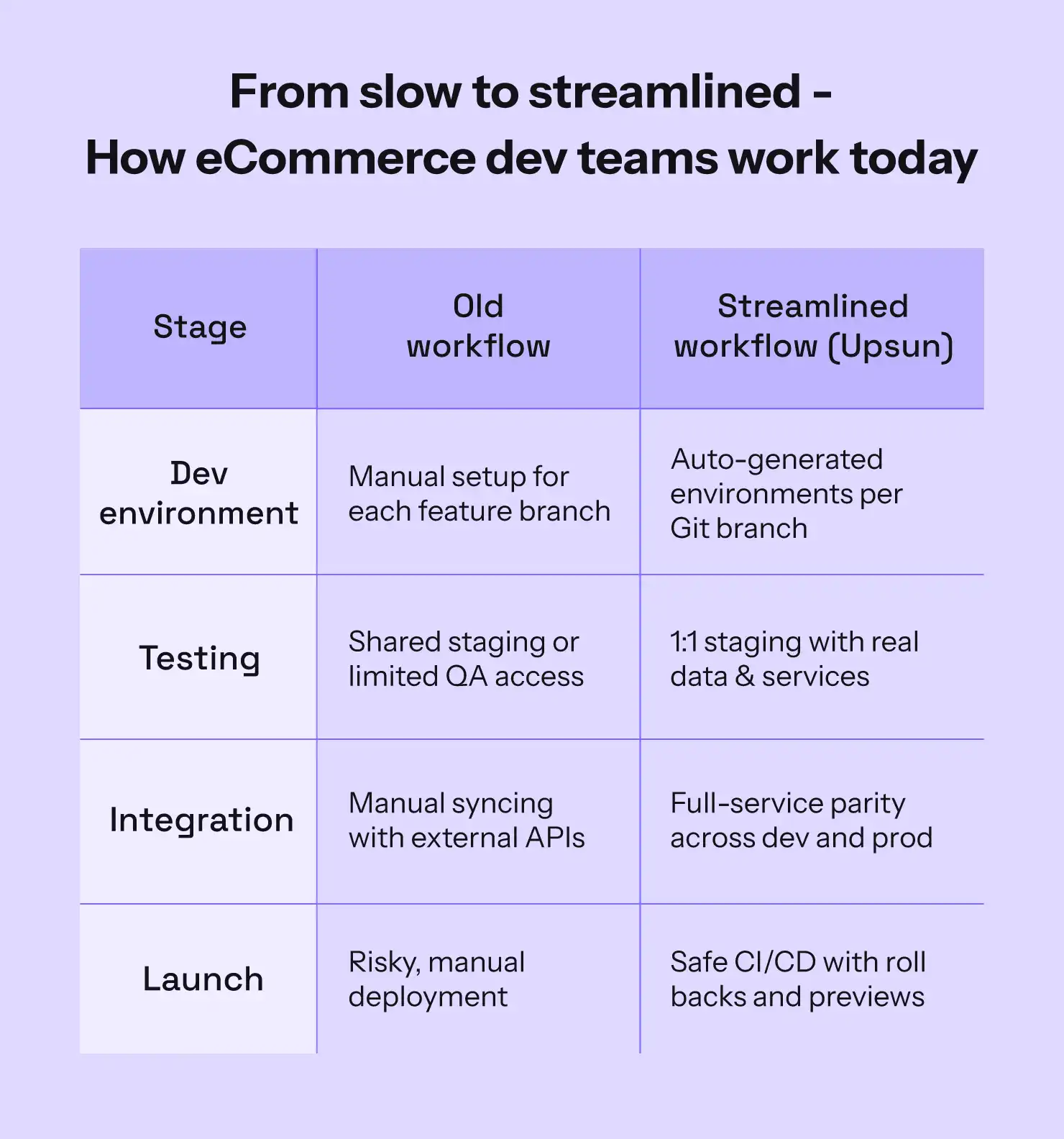
Why do ecommerce teams need safer, smarter workflows?
In eCommerce managed services, speed is not a luxury. It is the difference between catching a wave and missing it entirely. A holiday sale goes live at midnight. A product launch hinges on a single banner. A small delay can turn into lost revenue, and no one remembers why it happened, only that it occurred.
Why are time-sensitive campaigns vulnerable?
The biggest revenue days - Black Friday, Cyber Monday, Prime Day, Singles’ Day - are won or lost by milliseconds. A slow pipeline that adds even 24-48 hours per deployment can derail a meticulously planned promotion. By the time your fix is ready, your customer has already clicked away.
A broken workflow doesn’t just delay features. It kills opportunity.
Why is safe experimentation so elusive?
Innovation demands trial. Perhaps you would like to introduce a new recommendation engine. Or test out an alternate payment gateway. But where do you test? Production is too risky. And staging? Often a shadow of the real thing - unreliable, incomplete, and built for simulation, not precision.
Without a true sandbox, you can’t innovate without fear.
Why do non-developers struggle with the process?
Modern eCommerce isn't just run by engineers. Marketers want to test headlines. QA teams want to probe for edge cases. Legal wants visibility before launch. These contributors don't live in Git or terminal windows; they need environments that speak business, not just backend.
A dev-first workflow ignores the reality: shipping is now a team sport.
Why is environment parity non-negotiable?
In real-time commerce, staging must be indistinguishable from production. Same API versions. Same asset paths. Same data shapes. Otherwise, bugs hide in the gaps and appear only after a deploy has cost you real money.
A safer, faster workflow isn’t a tech upgrade. It’s a business defense mechanism.
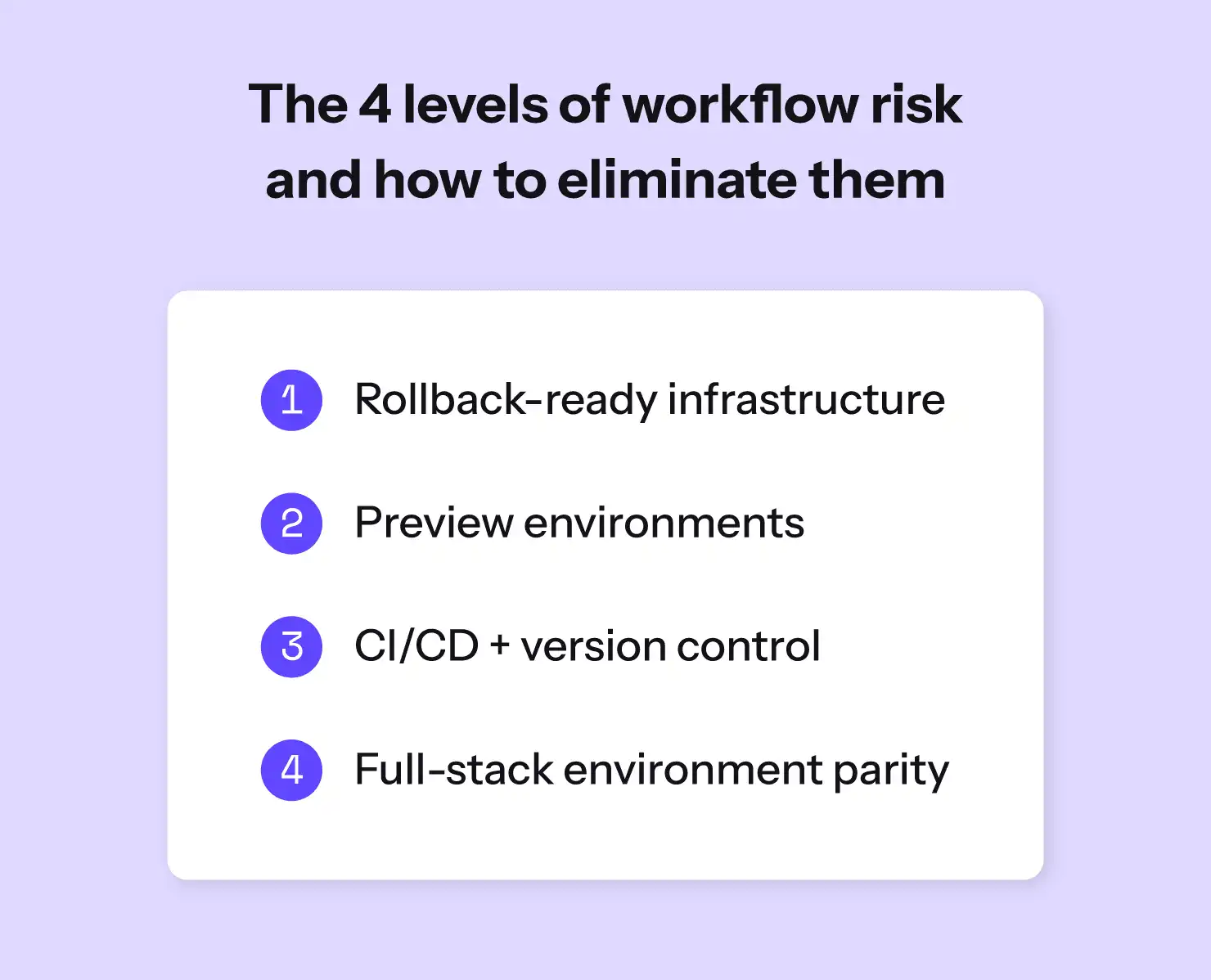
The step-by-step path to safer, faster, and low-risk deployments.
What separates ordinary workflows from high-performance pipelines?
In 1981, a pit crew changed a Formula 1 tire in 14 seconds. Today, it takes under 2. The difference wasn’t just better tools, it was better systems. Data tracking. Coordinated roles. Muscle memory refined by feedback loops.
The same pattern shows up in places far removed from racetracks. Especially in eCommerce.
Because speed in digital retail doesn’t just come from fast servers or lean code. It comes from workflows that are precise, predictable, and invisible when they work. What separates struggling teams from high-performing ones isn’t how quickly they deploy, but how confidently they do it.
Let’s look at the building blocks that make that confidence possible.
What is environment cloning and why does it matter?
When code works on your machine but fails in staging, the problem is not the code, it is the environment.
Environment cloning fixes this by creating an exact replica of production:
- Same APIs
- Same services
- Same quirks
With tools like Upsun, bugs caught in testing are the same ones you would have faced in production. That means fewer surprises, faster fixes, and a smoother path to launch.
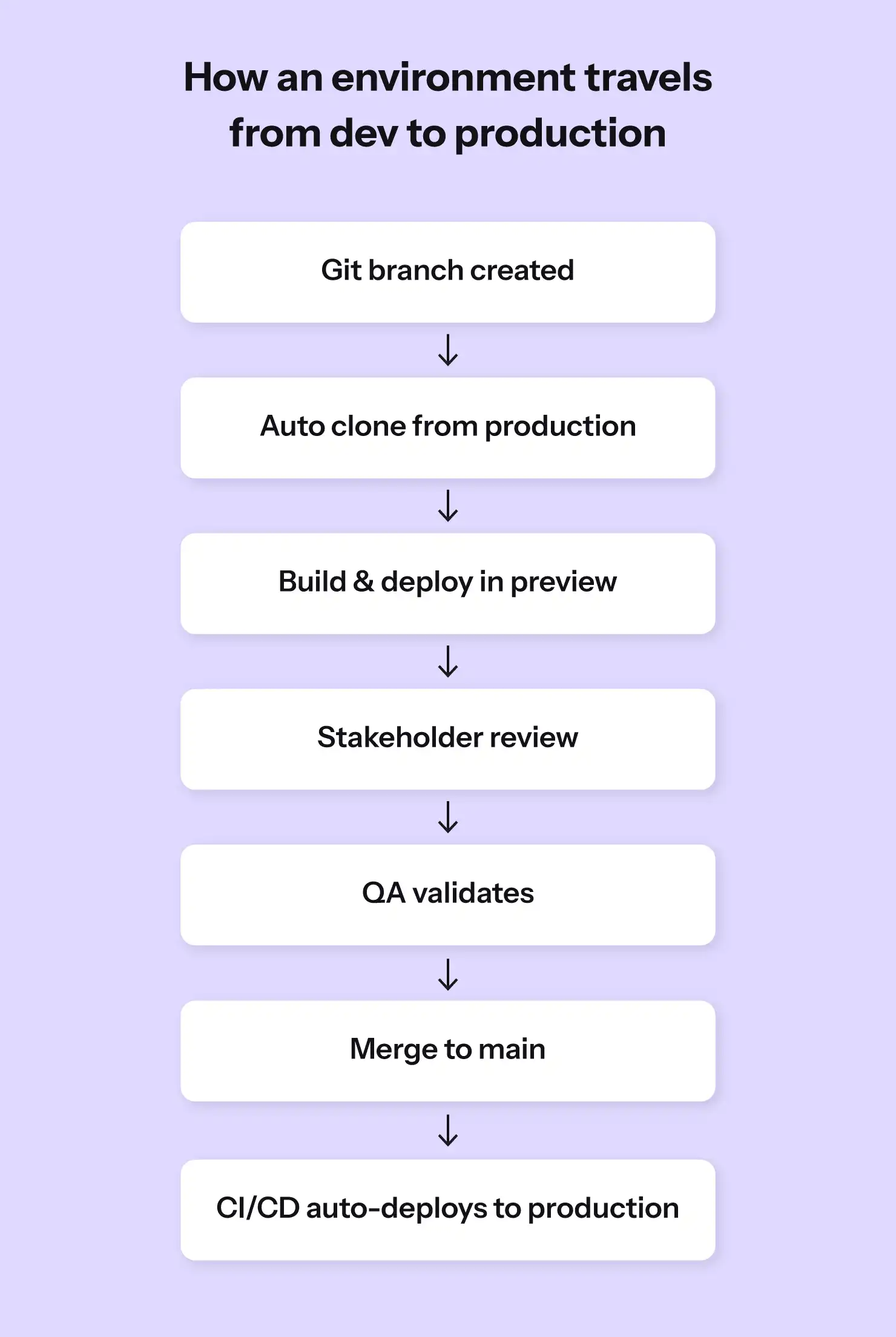
The journey every environment takes from development to production readiness.
How does branch-based development keep the pipeline moving?
Traditional workflows move in a straight line. One feature waits for the next, and a single failure blocks everyone.
Branch-based development changes the flow.
- Every feature lives in its own branch
- Teams test and review independently
- CI/CD runs automated checks
No collisions. No waiting. Just steady, predictable progress.
What are preview environments and why do they help?
How often have you heard, “Can I see it live?”
Preview environments give every branch a live, shareable link:
- No screenshots
- No staging confusion
- Real, testable builds for every stakeholder
This bridges the gap between technical and non-technical teams. Collaboration stops being a meeting and becomes a shared experience.
Why Does Infrastructure as Code Make Workflows Safer?
Over time, environments drift. Settings change, dependencies shift, and suddenly, something breaks.
Infrastructure as Code (IaC) locks your infrastructure into version-controlled code:
- Spin up production replicas in minutes
- Roll back instantly
- Track every change
When your infrastructure is written down, not remembered, deployment speed is matched by certainty. And certainty is what keeps revenue safe.
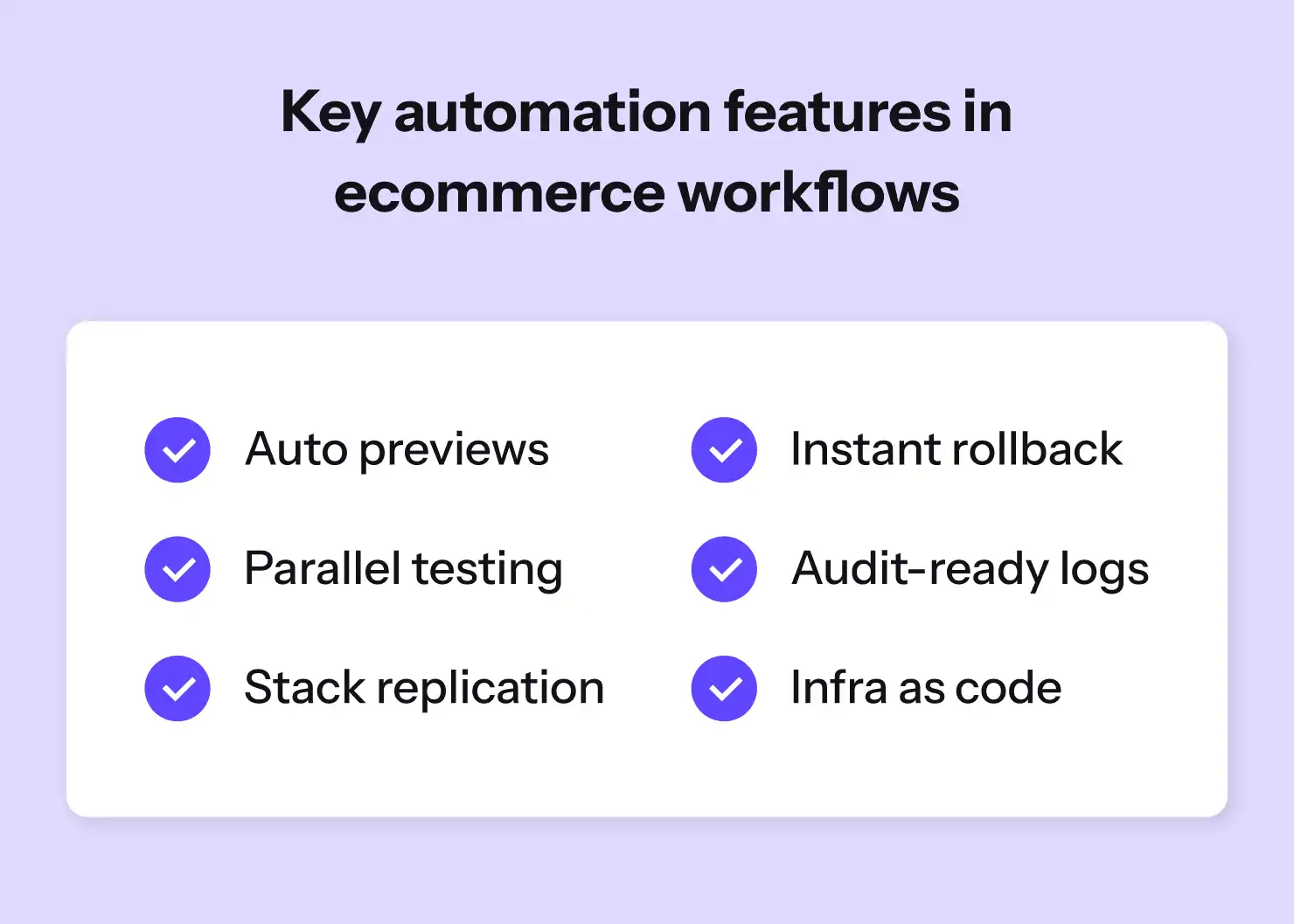
The core automation features that speed delivery and reduce errors.
How do you manage and scale complex commerce architectures?
Picture a busy kitchen. One chef handles the grill. Another preps vegetables. Someone else manages desserts. If they do not talk to each other, chaos follows. Modern eCommerce is no different. The storefront, the backend, payments, and search tools all have to work together. When they do, everything feels seamless. When they do not, it shows.
Why orchestration matters
Without orchestration, each part of the system goes its own way. That is when the late-night emergencies happen. A simple mismatch between staging and production can turn a routine release into a disaster. Platforms that keep every service in sync change that story. They turn unpredictable launches into a steady rhythm that teams can trust.
That is why many high-growth teams look for orchestration platforms that keep every service working in sync. Upsun does exactly that, turning complex launches into a smooth, predictable process.
Upsun in action
This is where Upsun shines. It mirrors every service in every environment. The database in staging behaves just like it does in production. The API gateway in testing acts the same way it will for real customers. That means fewer surprises, faster fixes, and launches that feel calm.
Simplifying scale
Growth adds layers. More tools. More services. More chances for things to break. Parity keeps all of it under control. When staging and production match, scaling is not scary. It is simple.
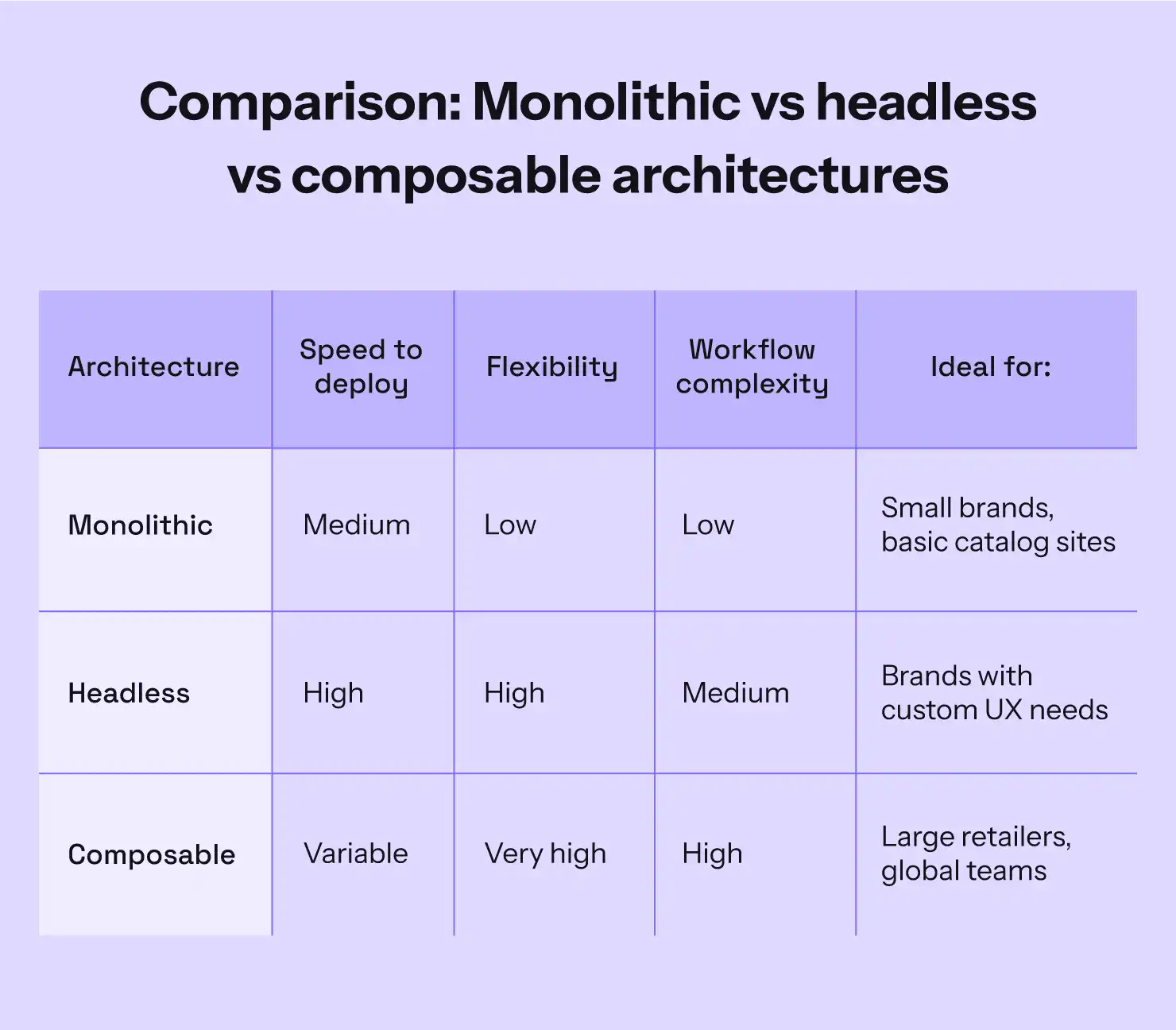
How different architectures impact speed, flexibility, and scalability for teams.
Real-world scenarios where workflow speed matters
Delays do not come from a single feature. They come from the spaces in between. The waiting. The rework. The "it worked in staging but not in production" moments that quietly eat up days.
When speed makes or breaks a campaign
Campaigns live or die by timing. If a launch slips, even the smartest idea will miss its chance. Fast workflows keep the window open.
The hidden cost of slow integration testing
Payment gateways, search tools, CMS plugins - every one of them needs testing. Slow environments turn testing into a bottleneck. Speed removes the roadblocks.
Expanding into new markets without losing time
Launching in a new region is hard enough. New storefronts, new languages, new rules. With fast workflows, teams can build and test in parallel, rather than waiting in line.
Final words
Speed in eCommerce is not a sprint. It is a steady, confident pace. The best teams do not gamble with every release. They repeat a process they can trust.
When parity is in place, launches no longer feel like cliff dives. They become routine. Predictable. Safe. The question is no longer "Can we move faster?" It is "Why would we ever slow down?"
This is where expertise meets technology. The right workflow and the right platform are a winning combination. Ziffity provides the strategic guidance and development expertise to transform your workflow, while Upsun provides the infrastructure engine to make it possible.
With Upsun, the answer is now.
Spin up new environments in minutes. Test without fear. Launch with confidence.
Start building smarter today with Ziffity and Upsun.
Your greatest work
is just on the horizon
CompareVercel alternativeAmazee alternativeHeroku alternativePantheon alternativeManaged hosting alternativeFly.io alternativeRender alternativeAWS alternativeAcquia alternativeDigitalOcean alternative
Join our monthly newsletter
Compliant and validated
